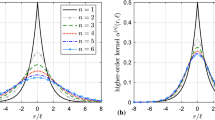We consider two-dimensional dynamic problems of the theory of elasticity, which can be reduced to singular integral or integrodifferential equations with immobile singularities. These problems include the problems of determination of the stressed state of bodies with edge defects and defects whose cross sections have the shape of broken line and some contact problems. For the solution of the obtained equations, we propose to apply a numerical method that takes into account the actual asymptotics of solutions and is based on the use of special quadrature formulas for singular integrals.
Similar content being viewed by others
References
R. V. Duduchava, “Integral convolution equations with discontinuous presymbols, singular integral equations with immobile singularities, and their applications to the problems of mechanics,” Trudy Tbilisi Mat. Inst. im. Razmadze Akad. Nauk Gruz. SSR, 60, 1–135 (1979).
G. S. Kit and M. G. Krivtsun, Plane Problems of Thermoelasticity for Bodies with Cracks [in Russian], Naukova Dumka, Kiev (1983).
G. S. Kit and M. G. Krivtsun, “Integral equations of the problem of thermoelasticity for a plane with curvilinear hole and cracks,” Dokl. Akad. Nauk Ukr. SSR. Ser. A, No. 11, 998–1001 (1976).
H. S. Kit, V. V. Mykhas’kiv, O. M. Khai, “Analysis of the steady oscillations of a plane absolutely rigid inclusion in a threedimensional elastic body by the boundary element method,” Prikl. Mat. Mekh., 66, No. 5, 855–863 (2002); English translation: J. Appl. Math. Mekh., 66, No. 5, 817–824 (2002); DOI: 10.1016/S0021-8928(02)90012-2.
G. S. Kit and O. V. Poberezhnyi, Nonstationary Processes in Bodies with Cracklike Defects [in Russian], Naukova Dumka, Kiev (1992).
G. S. Kit and. M. V. Khai, “Integral equations of three-dimensional problems of the theory of elasticity for bodies with cracks,” Dokl. Akad. Nauk Ukr. SSR. Ser. A, No. 12, 1108–1112 (1975).
G. S. Kit and. M. V. Khai, “Integral equations of three-dimensional problems of heat conduction for bodies with cracks,” Dokl. Akad. Nauk Ukr. SSR. Ser. A, No. 8, 704–707 (1975).
G. S. Kit and. M. V. Khai, Method of Potentials in Three-Dimensional Problems of Thermoelasticity for Bodies with Cracks [in Russian], Naukova Dumka, Kiev (1989).
H. S. Kit, R. M. Kushnir, V. V. Mykhas’kiv, and M. M. Nykolyshyn, “Methods for the determination of static and dynamic stresses in bodies with subsurface cracks,” Fiz.-Khim. Mekh. Mater., 47, No. 2, 56–66 (2011); English translation: Mater. Sci., 47, No. 2, 177–187 (2011); 10.1007/s11003-011-9382-9.
V. D. Kupradze, T. G. Gegeliya, M. О. Basheleishvili, and T. V. Burchuladze, Three-Dimensional Problems of the Theory of Elasticity and Thermoelasticity [in Russian], Nauka, Moscow (1976).
V. G. Popov, “Harmonic vibrations of a half space with a surface-breaking crack under conditions of out-of-plane deformation,” Izv. Ross. Akad. Nauk. Mekh. Tverd. Tela, No. 2, 96–105 (2013); English translation: Mech. Solids, 48, No. 2, 194–202 (2013); 10.3103/S0025654413020118.
V. G. Popov, “Harmonic vibrations under the conditions of antiplane deformation of a half space containing a thin rigid striplike inclusion crossing the boundary,” Mat. Met. Fiz.-Mekh. Polya, 56, No. 2, 124–135 (2013); English translation: J. Math. Sci., 203, No. 2, 149–164 (2014); 10.1007/s10958-014-2097-3.
V. G. Popov, “Diffraction of elastic shear waves on an inclusion of complex shape in an unbounded elastic medium,” in: Hydroaeromechanics and Theory of Elasticity: Numerical and Analytic Methods for the Solution of Problems of Hydroaerodynamics and Theory of Elasticity [in Russian], Dnepropetrovsk State University, Dnepropetrovsk (1986), pp. 121–127.
V. G. Popov, “Torsional vibration of an elastic cylinder bound to an elastic half space,” Visn. Kyiv. Nats. Univ im. T. Shevchenko. Ser. Fiz.-Mat. Nauky, Special Issue, 207–212 (2015).
V. G. Popov, “Stress state of a finite elastic cylinder with a circular crack undergoing torsional vibrations,” Prikl. Mekh., 48, No. 4, 86–93 (2012); English translation: Int. Appl. Mech., 48, No. 4, 430–437 (2012); DOI: 10.1007/s10778-012-0530-1.
V. G. Popov, “Comparison of the fields of displacements and stresses in the process of diffraction of elastic shear waves on various defects: crack and thin rigid inclusion,” Dinam. Sistemy, Issue 12, 35–41 (1993).
V. G. Popov and O. V. Lytvyn, “Stress state of an elastic body with rigid inclusion in the form of a broken line under harmonic wave loads,” Mat. Met. Fiz.-Mekh. Polya, 62, No. 3, 38–47 (2019); English translation: J. Math. Sci., 263, No. 1, 39–51 (2022).
J. Balaš, J. Sládek, and V. Sládek, Stress Analysis by Boundary Element Methods, Elsevier, Amsterdam (1989).
C. A. Brebbia and S. Walker, Boundary Element Techniques in Engineering, Newnes-Butterworths, London (1989).
V. Popov, “Interaction of a harmonic longitudinal shear wave with a broken line shaped crack,” Int. J. Math. Phys., 1, No. 2. (2018) (to be published).
C. Zhang and D. Gross, “On wave propagation in elastic solid with cracks,” in: Ser.: Advanced Fracture Mechanics, Vol. 2, Computational Mechanics Publications, Southampton (1998).
Author information
Authors and Affiliations
Corresponding author
Additional information
Translated from Matematychni Metody ta Fizyko-Mekhanichni Polya, Vol. 63, No. 1, pp. 94–105, January–March, 2020.
Rights and permissions
Springer Nature or its licensor (e.g. a society or other partner) holds exclusive rights to this article under a publishing agreement with the author(s) or other rightsholder(s); author self-archiving of the accepted manuscript version of this article is solely governed by the terms of such publishing agreement and applicable law.
About this article
Cite this article
Popov, V.G. Two-Dimensional Dynamic Problems of the Theory of Elasticity Reduced to Singular Integral Equations with Immobile Singularities. J Math Sci 270, 107–122 (2023). https://doi.org/10.1007/s10958-023-06335-y
Received:
Published:
Issue Date:
DOI: https://doi.org/10.1007/s10958-023-06335-y




